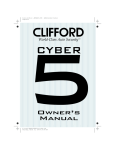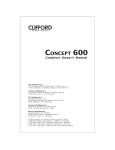Download Clifford concept 30 User's Manual
Transcript
World-Class Auto Security TM concept 30 Owner's Manual World-Class Auto Security TM concept 30 Installation Manual Table of Contents Standard Features of the Concept 3O Welcome . . . . . . . . . . . . . . . . 3 . . . . . . . . . . . . . . . . . . . . . . . . . . . . . . . . 5 Your 4-button/12-channel remote controls . . . . . . . . . . . . . . 6 How to use your keychain remote control . . . . . . . . . . . . . . . . 6 To transmit either channel 1, 2, 3 or 4 . . . . . . . . . . . . . . . . . . 6 To transmit either channel 5, 6, 7 or 8 . . . . . . . . . . . . . . . . . . 6 To transmit channel 9, 10, 11 or 12 . . . . . . . . . . . . . . . . . . . 6 What each button/channel does . . . . . . . . . . . . . . . . . . . . . 7 AntiScan™ . . . . . . . . . . . . . . . . . . . . . . . . . . . . . . . . 8 Anti-CodeGrabbing™ (ACG) with random code encryption . . . 9 Enhanced AutoArming™ . . . . . . . . . . . . . . . . . . . . . . . . 9 AutoArming enable/disable . . . . . . . . . . . . . . . . . . . . . . . . 9 Visual acknowledgment . . . . . . . . . . . . . . . . . . . . . . . . . . 9 AutoArm & Lock . . . . . . . . . . . . . . . . . . . . . . . . . . . . . . . 9 Instant AutoArming bypass . . . . . . . . . . . . . . . . . . . . . . . . . 9 UltraSecure™ Coded Valet Mode . . . . . . . . . . . . . . . . . . . 10 Your secret valet code . . . . . . . . . . . . . . . . . . . . . . . . . . . 10 Definitions . . . . . . . . . . . . . . . . . . . . . . . . . . . . . . . . . . 10 Digit . . . . . . . . . . . . . . . . . . . . . . . . . . . . . . . . . . . . 10 Valet code . . . . . . . . . . . . . . . . . . . . . . . . . . . . . . . . 10 PlainView switch . . . . . . . . . . . . . . . . . . . . . . . . . . . . . 10 Entering a digit . . . . . . . . . . . . . . . . . . . . . . . . . . . . . . 10 Entering a code . . . . . . . . . . . . . . . . . . . . . . . . . . . . . 10 To enable valet mode . . . . . . . . . . . . . . . . . . . . . . . . . . . 11 Keyless entry in valet mode . . . . . . . . . . . . . . . . . . . . . . . 11 To exit valet mode . . . . . . . . . . . . . . . . . . . . . . . . . . . . . 11 How to set your own secret valet code . . . . . . . . . . . . . . . . . . 11 1 Table of Contents (cont.) Dual-sensor protection . . . . . . . . . . . . . . . . . . . . . . . . . 12 Smart AutoTesting™ . . . . . . . . . . . . . . . . . . . . . . . . . . 12 Specific malfunction identification . . . . . . . . . . . . . . . . . . . . . 12 Automatic malfunction bypass . . . . . . . . . . . . . . . . . . . . 12 TotalRecall™ . . . . . . . . . . . . . . . . . . . . . . . . . . . . . . 13 Remote headlight activation OR window/sunroof closure . . . . . 13 Headlight reminder . . . . . . . . . . . . . . . . . . . . . . . . . . 13 FACT™— False Alarm Control and Test . . . . . . . . . . . . . . . . 14 How to interpret the chirps and parking light flashes . . . . . . . . 14 Smart prior intrusion attempt alert . . . . . . . . . . . . . . . . . . 14 Automatic starter interrupt . . . . . . . . . . . . . . . . . . . . . . . 14 AutoLock/AutoUnLock™ . . . . . . . . . . . . . . . . . . . . . . . 15 How to interpret the LED status indicator . . . . . . . . . . . . . . . 15 High-output Insignia™ siren . . . . . . . . . . . . . . . . . . . . . . 15 QuietChirps™ . . . . . . . . . . . . . . . . . . . . . . . . . . . . . . . . 15 Long-term chirp silencing . . . . . . . . . . . . . . . . . . . . . . . . . 15 Remote controlled chirp muting . . . . . . . . . . . . . . . . . . . . . . 15 Siren duration . . . . . . . . . . . . . . . . . . . . . . . . . . . . . . . . 15 SmartPowerUp™ . . . . . . . . . . . . . . . . . . . . . . . . . . . . 15 User-selectable features . . . . . . . . . . . . . . . . . . . . . . . . 16 Programming table for user-selectable features . . . . . . . . . . . . . 16 Adding new remote controls . . . . . . . . . . . . . . . . . . . . . . . 18 How to erase the codes of lost or stolen remote controls . . . . . . . . 18 2 Standard Features of the Concept 3O ✔ $3,OOO AntiTheft Guarantee — Pays you up to $3,000 if your vehicle is stolen and not recovered (see the AntiTheft guarantee card for details). ✔ Limited Lifetime Warranty — Your system control unit and remote controls are covered for as long as you own your vehicle (see the warranty card for details). ✔ FACT™ — False Alarm Control and Test — Eliminates recurring false alarms. ✔ A Pair of 4-Button/12-Channel Remote Controls — For fingertip command of your Concept 3O system from up to 100 feet away. ✔ AntiScan™ — Blocks electronic scanners from disarming your system. ✔ Proprietary Anti-CodeGrabbing™ (ACG) with Random Code Encryption™ — Since the remote control never transmits the same code twice, the random code encryption makes the new remote control code-grabbers used by thieves completely useless. ✔ Multiple-Car Control — Allows you to command Concept Series systems on your other vehicle(s) with the same remote control. ✔ Patented Remote Control Code Learning and MultiRemote™ Recognition — Allows you to add or delete, with just a few flicks of a switch, up to 4 different Clifford Anti-CodeGrabbing remote controls. ✔ Patent-Pending UltraSecure Coded Valet Mode — Ensures that no thief can turn off your Concept system like they can all other alarm brands. ✔ Remote Headlight Activation Capability — Remotely turn on your vehicle’s headlights to illuminate your way to and from your car. ✔ Remote Window and Sunroof Closure Capability *— Fully close all the power windows and sunroof with a press of a button on your remote control. ✔ QuietChirps™ — Select soft or full volume arm/disarm chirp confirmations. ✔ Dual-Mode Chirp Silencing — Long-term chirp silencing or remote controlled chirp muting. ✔ Smart Trunk Release Capability — Electronic interlock ensures that the trunk can be remotely opened only when the alarm is disarmed. ✔ Remote Door Locking/Unlocking — Lock/unlock the car doors with the remote. ✔ AutoLock™ — Automatically locks the doors when the engine is started. ✔ AutoUnLock™ — Automatically unlocks when the ignition is turned “off” ✔ Deluxe Remote Keyless Entry in Valet Mode — Allows for remote door locking/ unlocking with visual confirmations even while the system is in valet mode. ✔ Remote Courtesy Lighting — Turns on your car’s interior lights when you disarm and keeps them on for 30 seconds or until you start the engine. 3 Standard Features of the Concept 3O (cont.) ✔ Built-In Parking Light Flasher — Visually confirms alarm status from a distance. ✔ Headlight Reminder — You’ll never leave the headlights on after parking. ✔ Patented Smart AutoTesting™ — Automatically tests all system sensors and triggers, and identifies any malfunction. ✔ Patented Malfunction AutoBypass™ — Automatically bypasses any faulty point. ✔ Dual-Sensor Protection — The Magnetic Resonance Sensor detects intrusion-related vibrations and the Proximity Sensor detects anyone reaching or leaning into the passenger compartment. ✔ TotalRecall™ — Non-volatile memory stores the identity of the last trigger or sensor activated. ✔ Smart AutoArming™ — Automatically (passively) arms itself if you forget. AutoArming Enable/Disable — Enable or disable AutoArming any time. Visual Acknowledgment — Visually confirms initiation of the 30-second AutoArming countdown with two flashes of the parking lights. User-Selectable AutoArm & Lock — Allows you to select whether the doors will lock when the system AutoArms. Instant AutoArming Bypass™ — Lets you temporarily turn off AutoArming with just a turn of the ignition key. ✔ Patented Smart Prior Intrusion Attempt Alert — Specifically identifies the sensor or trigger activated by an attempted intrusion while you were away. ✔ High-Output Insignia™ Siren — Designed exclusively by Clifford Electronics for greater performance and 10 times the reliability of other alarm’s generic sirens. User-Selectable 30/60 second siren duration. Patented Automatic Noise Abatement — Limits alarm sounding to no more than 5 siren duration cycles to prevent battery drain and towing of the vehicle due to noise pollution. ✔ Fault-Proof Starter Interrupt — Prevents an intruder from starting the engine while the system is armed. ✔ High-Luminescence LED Indicator — Adds visual deterrence and provides visual confirmation of system status. ✔ Full-Time Remote Panic Feature — Lets you remotely activate the Insignia siren and parking lights inside or outside the vehicle, or even while driving. ✔ Multiple Trigger/Sensor Inputs — For greater security and precise identification of the exact trigger or sensor tripped in a prior intrusion attempt. *On various models of BMW, Jaguar and Volkswagen. 4 Welcome to the world of high-technology vehicle security and convenience C ongratulations on the purchase of your Clifford Concept 30 remote controlled vehicle security and convenience system. Your Concept 30 is packed with protective features and lifestyle convenience benefits that other car alarm companies don’t even have on their wish lists, let alone their alarms. Features like AntiCodeGrabbing™ that fights off the latest and most onerous threat from high-tech thieves. A thief equipped with a code-grabber can record with total impunity the codes of your car alarm’s remote control from up to several hundred feet away. How? The thief simply waits for you to arm or disarm your alarm with your remote control. The thief’s portable, pocket-sized code-grabber will automatically pick and record the transmitted code off the air. As soon as you walk away, he simply plays it back, instantly disarming your alarm and unlocking the doors. It’s like giving the thief your car keys. Code-grabbing will instantly defeat all other brands of remote controlled car alarms, regardless of whether they are equipped with anti-scanning or trillions of digital codes. Clifford’s unique PlainView™ Coded Valet switch ensures that no thief, carjacker or joy-rider can turn off your Concept 30 like they can with all other car alarm brands. Plus there’s QuietChirps™, remote controlled chirp muting, for your safety and convenience built-in circuitry for remote headlight control or, on certain vehicles, remote window rollup that saves you the cost of optional modules. And, for your peace of mind, we back it all up with a lifetime warranty and a $3,000 AntiTheft guarantee (see the enclosed cards for details). Yet despite all the sophistication, your Concept 30 is amazingly easy to use: never more difficult than a few flicks of a switch or a press of a button on one of your miniature keychain remote controls. 5 Your 4-button/12-channel remote controls The 4-button/12-channel remote control is an ultra-sophisticated miniature radio transmitter powered by a tiny 12-volt battery. Range is up to 100 feet. Obstructions, electrical interference, weather conditions or a weak battery will reduce the range. Your 4-button/12-channel remote control is the key to your Concept 30. It incorporates Clifford’s proprietary Anti-CodeGrabbing™ (ACG) technology with Random Code Generation for the ultimate in protection against thieves “code-grabbing” devices (see page 9). You’ll use the remote control to arm and disarm the system, lock and unlock the doors, activate the system’s panic feature, turn on the headlights and command options such as a remote trunk release and remote engine starter. How to use your keychain remote control Your remote control can command up to 12 different system functions and options. It’s like having a TV with 12 channels. You change channels (functions) with your keychain remote. But instead of putting 12 buttons on the remote, we made it easy: First, the button you use the most — button 1 to arm, disarm,lock and unlock — is larger than the others. Buttons 2, 3 and 4 are the smaller buttons to the right, below and left of button 1. The LevelShift button on the side permits you to select channels 5–12 with the same four buttons. To transmit either channel 1, 2, 3 or 4: Just press either button 1, 2, 3 or 4. For instance, to transmit channel 3, press button 3. While you transmit, the LED indicator will blink once every second: this indicates level 1. To transmit either channel 5, 6, 7 or 8: Press the LevelShift button once. This shifts buttons 1–4 to level 2 (channels 5–8). Then press the desired button within the next 7 seconds. For instance, to transmit channel 5, press the LevelShift button once, then press button 1. While you transmit, you’ll notice that the LED indicator blinks twice, pauses, blinks twice, etc.: this indicates level 2. To transmit channel 9, 10, 11 or 12: Press the LevelShift button twice. This shifts buttons 1–4 to level 3 (channels 9–12). Then press the corresponding button within the next 7 seconds. For instance, to transmit channel 10, press the LevelShift button twice, then press button 2. While you transmit, you’ll notice that the LED blinks three times, pauses, blinks three times, etc.: this indicates level 3. NOTE: One second after you stop transmitting level 2 or level 3 (channels 5–12), the remote control automatically returns to level 1 (channels 1–4). 6 What each button/channel does Your Concept 30 remote controls come pre-programmed so that certain channels command certain functions. If you wish, you can actually assign any channel to any function (see pages 16–18). The following chart indicates what each remote control channel number does, and how to transmit each channel number. Factory settings of the 12 remote control channels Transmitting channel number: Causes the system to: Press the How Press LevelShift many button button? times? number 1 arm or disarm and lock or unlock the doors no — 1 2 pop the trunk* (if the system is disarmed) AND turn on the headlights* or close the windows* (if the system is armed) no — 2 3 silently arm or disarm no — 3 4 activate optional accessory function #1 no — 4 5 activate optional accessory function #2 yes once 1 6 activate optional accessory function #3 yes once 2 7 activate optional accessory function #4 yes once 3 8 activate optional accessory function #5 yes once 4 9 activate optional accessory function #6 yes twice 1 10 activate optional accessory function #7 yes twice 2 11 activate optional accessory function #8 yes twice 3 12 activate optional accessory function #9 yes twice 4 * May require additional wiring. TO ARM THE SYSTEM . . . . . . . Press button 1 (channel 1) once. You will hear two chirps and the parking lights will flash twice. The dashboard LED will flash repeatedly and the car doors will automatically lock. TO DISARM THE SYSTEM . . . . . . . Press button 1 (channel 1) again. One chirp and one flash of the parking lights will confirm disarming. In addition, the car doors will automatically unlock and the interior lights will turn on and stay on for 30 seconds or until you start the engine, whichever occurs first.. continued . . . 7 TO ACTIVATE THE PANIC FEATURE . . . . . . . . . . Press button 1 for 3 seconds. The lights will flash repeatedly and the Insignia™ siren will blare for 30 or 60 seconds (user-selectable), or until you press button I again to turn it off. TO SILENTLY ARM OR DISARM THE SYSTEM . . . . . . . Press button 3 (channel 3). Your Concept 30 system will arm or disarm with all the indications noted on the previous page except for the chirp acknowledgments. TO REMOTELY TURN ON THE HEADLIGHTS — OR — REMOTELY CLOSE THE WINDOWS WHILE THE SYSTEM IS ARMED . . . . . . . . . Button 2 (channel 2) controls an electronic interlock that allows you to separately command two different options with the same channel: one when the system is armed and another when it is disarmed. For instance, if your Concept 30 was so wired, pressing button 2 while the alarm is armed will either turn on the headlights for any duration you wish between 1 second and 2.5 minutes (see the Built-In Timer feature in the User-selectable features section on pages 16–17) OR will fully close all the power windows and sunroof on various Jaguar, BMW and Volkswagen vehicles. TO REMOTELY OPEN THE TRUNK . . . As noted above, button 2 (channel 2) can control yet another option when the system is disarmed. The most obvious one is the remote trunk release. If you have this option installed, pressing button 2 while the alarm is disarmed will remotely open the trunk. TO ACTIVATE OTHER OPTIONS REGARDLESS OF ALARM STATE . . . . . . . Button 4 (channel 4) and channels 5–12 (see How to use your keychain remote control on page 6) can activate other accessories such as the Clifford IntelliStart remote engine starter, remote memory seat activation or SmartWindows II remote window roll-down and venting, as well as single Programmable Receiver(s) that lets you command your electric garage door and/or gate opener(s), etc. You may also assign any of these channels to control Clifford systems on your other vehicle(s). AntiScan™ Thieves can disarm some other brands of car alarms with a “scanner” that rapidly transmits one remote control code after another. Clifford’s AntiScan will detect any scanner and block the codes it generates. 8 Anti-CodeGrabbing™ (ACG) with Random Code Encryption A Clifford exclusive that protects you and your automobile from the most effective and onerous car stealing device ever used by car thieves — a code-grabber. Codegrabbers are far more effective and efficient than scanning (see page 8). Unlike scanners that sequentially transmit one digital code after another hoping one of them is the correct code to disarm the alarm (a process that may take hours, days or even years depending on the alarm’s number of codes), code-grabbers literally record, from hundreds of feet away, the code sent by your car alarm remote control. A code-grabber will instantly duplicate any remote control code, even if the remote has billions or trillions of codes. The thief simply waits for you to arm your alarm with the remote control and walk away. Then he plays back the code, instantly disarming your car’s alarm and unlocking the doors. It’s like giving the thief your car keys. All non-Clifford alarms can be defeated that easily. In contrast, Concept systems use complex digital signal processing and unbreachable encryption to randomly change the digital code every time you use the remote. Your remote will never transmit the same code. Thus the code recorded and played back by the thief’s code-grabber will never be accepted by your Concept 30. Only ACG can make a car alarm impervious to code-grabbing, and only Clifford systems have ACG with Random Code Encryption. Enhanced AutoArming™ If this feature is enabled and you forget to remotely arm your Concept 30, the system will arm itself automatically (“passively”) 30 seconds after the vehicle doors are closed. For your convenience, if you re-open any door(s) within the 30-second countdown, AutoArming will restart from the beginning once all doors are closed. Concept 30 includes all these additional Enhanced AutoArming features: AutoArming enable/disable: If you prefer, you may deactivate or reactivate the AutoArming feature. See User-selectable features on pages 16–17. Visual acknowledgment: Five seconds after you exit the vehicle and close all the doors, the parking lights will flash twice to confirm that the AutoArming countdown is progressing. Then, 25 seconds later, the system will AutoArm. AutoArm & Lock: To ensure you can’t accidentally lock your keys inside the car, the system is factory-set not to lock the doors upon AutoArming. To change this setting, see User-selectable features on pages 16–17. Instant AutoArming bypass: Prevents AutoArming when fueling the vehicle and other times when you wish to temporarily bypass AutoArming. To activate Instant AutoArming Bypass, rapidly turn the ignition switch to “ON” then “OFF.” You will hear a single siren chirp to confirm that the system will not AutoArm. The system reverts to its normal operating mode when you next start the engine. NOTE: To prevent AutoArming when fueling the vehicle, either use the Instant AutoArming Bypass feature noted above, or leave one of the doors open. 9 UltraSecure™ Coded Valet Mode Your secret valet code Within seconds, thieves can disable all other alarm brands by hot-wiring the ignition and flicking an easy to find “hidden” valet switch. Your Concept 30 has safeguards that absolutely ensure that a thief cannot enable the valet mode as a way of “turning off” your system. How? To enable valet mode, the driver must first enter a secret valet code on the PlainView switch. Your code will be a 1-to-3-digit number of your choosing. Each digit can be any number from 1 to 9, (i.e. the code can be any number between 1 and 999, except those that contain a zero). Whenever the system is put in valet mode, all of the system’s security features are switched off. At various times, you will need to switch the system off. For instance, when having your car serviced, washed or parked by a valet. NOTE: If you temporarily lose the use of your remote controls, you can disarm the system by enabling valet mode. Definitions Digit: A digit is defined as any number from 1 to 9, inclusive. Valet code: A valet code may be 1 to 3 digits: A one-digit code=X=any number between 1-9 A two-digit code=XY=any number between 11-99 (excluding numbers with zeros) A three-digit code=XYZ=any number between 111-999 (excluding numbers with zeros) Remember, no code can have a zero. A rocker switch mounted on the dashboard or console. The switch has three positions: 1.) Latched 2.) Center 3.) Spring-loaded momentary. When you press the latched side, the switch remains in its pressed position. When you press the momentary side, the switch bounces back to the center position. Entering a digit: To enter a digit, you tap (press and release) on the momentary side of the PlainView switch the number of times corresponding to the numeral of the digit to be entered, followed by pressing to the latched side, then returning the switch to its center position. Entering a code: If your code has only one digit, enter the code as described in “Entering a digit,” then return the switch to its center position. If your code has more than one digit, just repeat the above for each digit of your code, then return the switch to its center position. PlainView switch: Currently, your factory-set valet code is the single digit “2.” 10 To enable valet mode 1. Turn the ignition switch to its “ON” position or start the engine. 2. Enter your secret valet code, then return the switch to its center position. 3. You now have 3 seconds to press the latched position (valet mode). Once you have entered valet mode, the system’s LED will glow continually for on-going visual confirmation of valet mode. Keyless entry in valet mode: Even if valet mode is enabled, you can still remotely control the convenience features. For instance, simply press button 1 (channel 1) as if you were disarming. The doors will unlock (as indicated by one flash of the parking lights) and the interior lights will illuminate. Press button 1 (channel 1) again and the doors will lock (as indicated by two flashes of the parking lights). You can also use the remote control’s other channels to activate options such as a remote trunk release or remote engine starting. To exit valet mode 1. Turn the ignition switch to its “ON” position or start the engine. 2. Flick the switch back to its center position. The LED will turn off to confirm that the system is now in its normal operating mode. How to set your own secret valet code Since all Concept 30 systems have the same factory-set code, it is highly advisable that you set your own valet code. You may choose any 1-, 2-, or 3-digit code that does not have any zeros. You can also change your valet code whenever you want. 1. Write down the 1-to-3 digit code you wish to use (remember, no zeros in the code). 2. Turn your vehicle’s ignition switch to its “ON” position. 3. Enter your current valet code (if this is the first time you are setting a new code, enter the factory-set code of “2” by tapping the momentary [spring-loaded] side of the switch twice, then pressing the latched side). 4. When the LED turns on, immediately tap and release the momentary side of the switch 8 times (after the first three taps, you will hear a single chirp confirmation each time you tap the momentary side — in this case for a total of 5 chirps). 5. Immediately after the 5th chirp, press the latched side of the switch, then enter each digit of your new code. After each digit of your code is entered by pressing the latched side, you will hear the same number of chirps as the digit you just entered. When done, return the switch to its center position. You will hear 1 chirp and the LED will turn off. Turn the ignition off and you will hear 3 chirps to indicate that you have exited programming mode. 6. VERY IMPORTANT: You must immediately test your new valet code to ensure that you entered it correctly. To do so, turn the ignition on, enter your new code, then press the latched side. The LED should be illuminated. NOTE: If the LED does not illuminate, your new code was entered incorrectly. The system has automatically reverted to the previous valet code. 11 Example of setting a new valet code: Let’s say you want to change the code from its original single-digit “2” code to a double-digit code of “31.” You would do the following: Turn the ignition on, enter your current code, tap the momentary side of the PlainView switch 8 times, press the latched side, then enter the new code: momentary, momentary, momentary, latched (3 chirps), momentary, latched (1 chirp), center. Wait 2 seconds for the system to exit program mode (1 chirp and the LED turns off), then turn the ignition off (3 chirps). Dual-sensor protection Your Concept 30 system has two sensors: a Proximity Sensor that uses a radar field to detect anyone leaning into the passenger compartment, and a Magnetic Resonance Sensor that detects intrusion-related vibrations and impacts. For an even greater level of security, consider Clifford Electronics optional sensors: OmniSensor (a digital analysis vibration/impact sensor) and/or the Glass Tampering Sensor (which detects attempts to break any of the vehicle’s windows). Smart AutoTesting™ Each time you remotely arm your Concept 30, it will perform a series of tests on all triggers and sensors. If the hood or trunk is open when you arm the system, your Concept 30 will immediately alert you of the problem by issuing 4 chirps and 4 parking light flashes instead of the usual 2 and 2. If one of the sensors is malfunctioning, you will receive the usual 2 chirps and flashes, then, 5 seconds later, there will be 4 chirps and 4 flashes. NOTE: Since this is a warning indication, you will hear the 4 chirps even if you have the chirp muting feature turned on. Specific malfunction identification: The system can also indicate the specific malfunctioning trigger or sensor. This saves you time and money since your installer won’t have to spend hours trying to determine where the problem is. Here’s how it works, if you receive the 4-chirp/4-flash signal upon disarming: 1. When you insert your key and turn on the ignition, the LED indicator inside the vehicle will be flashing, pause, then repeat. 2. Count the number of blinks in one cycle between pauses (for your convenience, the blink cycle repeats 5 times) and refer to the chart below: Number of LED blinks between pauses Malfunction 1 blink Magnetic Resonance Sensor 2 blinks Proximity Sensor 4 blinks Trunk trigger 5 blinks Hood trigger 12 Automatic malfunction bypass To provide the utmost protection even if a system component malfunctions, your Concept 30 will automatically bypass the faulty point and arm all other triggers and sensors until you can have the system serviced by your local Authorized Dealer. TotalRecall™ The system’s non-volatile memory records the identity of the last activated or malfunctioning trigger and/or sensor, which allows your installer to instantly track down malfunctions and save you substantial servicing costs. To identify the trigger and/or sensor held in the system’s non-volatile memory, perform the following procedure: 1. With the ignition OFF, flick the PlainView switch to its latched side. 2. Press button I to “arm” the system, then again to “disarm.” 3. The LED will blink 1–5 times, pause, then repeat the blink cycle 4 times. 4. Count the number of blinks in one cycle and refer to the chart below: Number of LED blinks per cycle Trigger/sensor that was activated or malfunctioned 1 blink Magnetic Resonance Sensor 2 blinks Proximity Sensor 3 blinks Door trigger 4 blinks Trunk trigger 5 blinks Hood trigger Remote headlight activation OR window/sunroof closure The system’s built-in timer can control one of two great features when the system is in its armed state (these features require optional wiring): Remote Controlled Headlight Activation OR Remote Controlled Window/Sunroof Closure (available only on certain vehicles) Please see page 8: “To remotely turn on the headlights OR remotely close the windows while the system is armed.” If connected to the headlights, you may set the timer to any interval between 1 sec. and 2.5 min. See User-selectable features on pages 16–17. WARNING: If your system’s built-in timer controls window/sunroof closure, DO NOT CHANGE THE TIMER SETTING! This requires installer-only programming. Changing the value will adversely effect operation and may cause damage. Headlight reminder If you turn the ignition off and open the driver’s door to exit the car without having turned off the headlights, you will be reminded to turn them off with a distinctive warning tone. If your vehicle already has a similar warning feature, you may turn off the Headlight Reminder feature. See User-selectable features on pages 16–17. 13 FACT™— False Alarm Control and Test With FACT, you’ll never experience repeated false alarms. If your Insignia™ siren goes off, DO NOT remotely disarm the system while the siren sounds; allow it to run for the full siren duration. Before sounding the siren a second time, the system automatically checks for another activated trigger or sensor to verify that an intrusion is in progress. Should the siren sound again, you will know for sure that someone is tampering with your vehicle. (To disable FACT, see User-selectable features on pages 16–17.) How to interpret the chirps and parking light flashes When you use the remote control, the system responds with chirps (unless the chirp muting feature is turned on) and parking light flashes. These chirp/flash acknowledgments mean: Chirps and flashes Meaning 1 Your Concept system is disarmed 2 Your Concept system is armed 2 and then 4 Armed but one of the sensors is malfunctioning (see Smart AutoTesting on page 12) 3 Disarmed and there was an intrusion attempt (see Smart Prior Intrusion Attempt on page 14) 4 Armed but the hood or trunk is open (see Smart AutoTesting on page 12) Smart prior intrusion attempt alert When you remotely disarm, if you hear three chirps and see three parking light flashes (instead of the usual one and one) it means that a trigger or sensor was activated in your absence. When you enter the vehicle and turn on the ignition (or start the engine), the LED will blink several times, pause, then repeat the blink cycle 4 more times. Count the number of blinks in one cycle and refer to the chart below: Number of LED blinks per cycle Trigger/sensor that detected the intrusion attempt 1 blink Magnetic Resonance Sensor 2 blinks Proximity Sensor 3 blinks Door trigger 4 blinks Trunk trigger 5 blinks Hood trigger Automatic starter interrupt Your Concept 30 automatically prevents engine starting while the system is armed. Clifford’s fault-proof design ensures that you can start the engine even in the unlikely event of a full system failure (other brands of alarms can leave the driver stranded). 14 AutoLock/AutoUnLock™ Concept 30 automatically locks the doors when you begin driving, and unlocks them when you turn off the ignition. If you prefer, you may turn off the AutoLock/ AutoUnLock feature. See the User-selectable features section on pages 16–17. How to interpret the LED status indicator The LED on your car’s dashboard or console will inform you of the system status: LED Condition Meaning Off System is disarmed and in normal operating mode (i.e., valet mode is off) On Valet mode is on, the vehicle can be driven or serviced without having to disarm Flashing System is armed and protecting your vehicle Pause between flashes Either a malfunction (see page 12) or an intrusion was attempted (see page 14) High-output Insignia™ Siren Clifford Electronics designed the Insignia Siren to provide greater performance and teen times the reliability of all other manufacturers’ look-alike, sound-alike sirens. QuietChirps™: You can control the volume of the normal arm/disarm chirps. As shipped from the factory, your system issues full-volume chirp acknowledgments. If you prefer, you may reduce the chirp volume to a level that is clearly audible, yet less obtrusive. See the User-selectable features section on pages 16–17. Long-term chirp silencing: Whenever you wish, you may silence your Concept 30’s arm/disarm chirps until you wish to restore them. The parking light flashes will continue to provide visual confirmation of remote controlled arming and disarming. See User-selectable features on pages 16–17. Remote controlled chirp muting: Remote controlled chirp muting capabilities are especially valuable when parking late at night in a quiet residential area. To arm or disarm silently, simply press button 3 (channel 3) on your remote control instead of the usual button 1 (channel 1). Siren duration: When the system detects an intrusion attempt, the alarm is set to sound for 30 seconds. However, if you prefer, you may change it to 60 seconds. See the User-selectable features section on pages 16–17. SmartPowerUp™ If power is ever removed and restored in a theft attempt, SmartPowerUp automatically re-arms the system, sounds the siren, flashes the parking lights and electronically interrupts the starter. To disconnect power for servicing, simply insert your key into the ignition and turn it to the “ON” position before reconnecting power. Concept 30 recognizes this an an authorized power reconnection and will not alarm. 15 User-selectable features Your Concept 30 vehicle security system allows you to set many of its features to your own personal preferences. We have made the programming procedures very simple: to make a change, you just press the PlainView switch a few times. The system comes from the factory with all of its features pre-programmed as noted in the table below and on page 17. To change any of the settings, use the procedure noted. To restore the feature to its factory setting, just repeat the procedure: 1. Select the feature you wish to program from the table below and on the following page. Note the number of momentary (spring-loaded) presses. 2. Turn your vehicle’s ignition switch to its “ON” position. 3. Enter your valet code. 4. When the LED turns on, immediately tap and release the momentary side of the switch the number of times indicated in the third column of the programming table for the feature you selected (after the first three taps, you will hear a single chirp confirmation each time you tap the momentary side). a. If noted, perform the “secondary action.” 5. Return the switch to its center position. You will hear 1 chirp and the LED will turn off. Turn the ignition off and you will hear 3 chirps to indicate that you have exited programming mode. 6. Repeat steps 1-5 for any other features you wish to program. Programming table for user-selectable features Feature # of Factory momentary setting taps Secondary action Program completion confirmation Result AutoArming ON 4 — 1 chirp 3 seconds after last step Change state from ON to OFF or vice-versa AutoArm & Lock OFF 5 — 1 chirp 3 seconds after last step Change state from ON to OFF or vice-versa Arm/Disarm Chirp Confirmation ON 6 — 1 chirp 3 seconds after last step Change state from ON to OFF or vice-versa QuietChirps OFF 7 — 1 chirp 3 seconds after last step Change state from ON to OFF or vice-versa Valet Code AutoLock/ AutoUnLock See How to set your own secret valet code on page 11. ON 9 1 chirp 3 seconds after last step — 16 Change state from ON to OFF or vice-versa Program completion confirmation Feature # of Factory momentary setting taps Siren Duration 30 sec. 10 — 1 chirp 3 Change duration from 30 to seconds after 60 seconds or vice-versa last step FACT — False Alarm Control and Test ON 12 — 1 chirp 3 seconds after last tap Change state from OFF to ON or vice-versa Headlight Reminder ON 13 — 1 chirp 3 seconds after last tap Change state from OFF to ON or vice-versa Add a New Remote to Channel 1 (arm/disarm) — 14 2 chirps Button 1/channel 1 code of the new remote control has been memorized Add a New Remote to Channel 2 (optional remote accessory) — 15 Press remote control button 2 2 chirps Button 2/channel 2 code of the new remote control has been memorized Add a New Remote to Channel 3 (silent arm/disarm) — 16 Press remote control button 3 2 chirps Button 3/channel 3 code of the new remote control has been memorized Add a New Remote to Channel 4 (optional remote accessory) — 17 Press remote control button 4 2 chirps Button 4/channel 4 code of the new remote control has been memorized 18 3 seconds later, 1 chirp will indicate that the timer has started. When the desired interval has passed, turn off the ignition key. — Set to any interval between 1 sec. and 2.5 min. Built-In Timer ✱ 30 sec. Secondary action Press remote control button 1 Result ✱ WARNING: If the built-in timer controls window/sunroof closure on your car, DO NOT change the timer setting! This requires installer-only programming. Changing the value will adversely effect operation and may cause damage. 17 Example To change the AutoArming feature from its factory setting of on to off, you would do the following: Turn the ignition key to the ON position. Enter your valet code, then immediately tap and release the momentary side of the PlainView switch 4 times (you will hear a single chirp upon the 4th press). Wait 3 seconds. The system will sound one more chirp to confirm that the AutoArming setting has been changed. Turn the ignition off (you’ll hear 3 chirps to confirm exit of program mode). That’s all there is to it! Adding new remote controls For other drivers in your family or if you wish to control Concept systems on your other cars with the same remote control, you can buy additional remote controls from any Authorized Clifford Dealer (or call our 24-hour Customer Service Department at 800-824-3208) and program them into the system yourself. Each Concept 30 will respond to as many as four 12-channel remote controls. To add a new remote control to the system, use the procedures noted in the User-selectable features section on pages 16–17. How to erase the codes of lost or stolen remote controls If one of your remote controls is ever lost or stolen, you can push its digital codes out of the system memory to make sure that the missing remote control can never be used to disarm your system. To do so, just re-program your current remote control(s) as noted in the User-selectable features section on pages 16–17 for a total of four times (e.g., if you have one remote control remaining, program it four times; if you have two remote controls, program each twice). 18 All Concept Series systems are covered by one or more of the following Clifford Electronics patents: 4,158,874; 4,233,642; 4,327,444; 4,383,242; 4,430,685; 4,845,464; 4,887,064; 4,890,108; 4,922,224; 4,997,053; 5,081,667; 5,146,215; 5,157,375 and other patents pending © Copyright Clifford Electronics, Inc., 1993 31-069D/C30OM/194










































